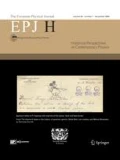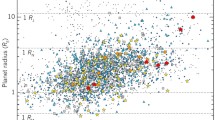Abstract
This oral history interview touches upon important topics like the dynamics of the discovery, in 1995, of 51 Pegasi b – the first extrasolar planet ever found around a normal star other than the Sun – the development of better and better equipment that made it possible, the importance it had in shaping a new community of scholars dealing with this new field of research, and, more at large, the cultural importance it had in overturning our view of the cosmos.
Similar content being viewed by others
References
Anglada-Escudé, G., P.J. Amado, J. Barnes, Z.M. Berdiñas, R.P. Butler et al. 2016. A terrestrial planet candidate in a temperate orbit around Proxima Centauri. Nature 536: 437–440
Antonov, V.A. 1962. Solution of the problem of stability of stellar system Emden’s density law and the spherical distribution of velocities. Vestnik Leningradskogo Universiteta 7: 135
Astudillo-Defru, N., T. Forveille, X. Bonfils, D. Ségransan, F. Bouchy et al. 2017. The HARPS search for southern extra-solar planets. XLI. A dozen planets around the M dwarfs GJ 3138, GJ 3323, GJ 273, GJ 628, and GJ 3293. Astronomy and Astrophysics 602: A88
Baranne, A., M. Mayor, J.L. Poncet. 1979. Coravel: a new tool for radial velocity measurements. Vistas in Astronomy 23: 279–316
Baranne, A., D. Queloz, M. Mayor, G. Adrianzyk, G. Knispel et al. 1996. Elodie: a spectrograph for accurate radial velocity measurements. Astronomy and Astrophysics Supplement Series 119: 373–390
Benz, W., M. Mayor. 1981. A new method for determining the rotation of late spectral type stars. Astronomy and Astrophysics 93: 235–240
Berta-Thompson, Z.K. et al. 2015. A rocky planet transiting a nearby low-mass star. Nature 527: 204–207
Brogi, M., I.A.G. Snellen, R.J. de Kok, S. Albrecht, J. Birkby et al. 2012. The signature of orbital motion from the dayside of the planet Tau Bootis b. Nature 486: 502–504
Brogi, M., R.J. de Kok, S. Albrecht, I.A.G. Snellen, J.L. Birkby et al. 2016. Rotation and winds of exoplanet HD 189733 b. Measured with high-dispersion transmission spectroscopy. Astrophysical Journal 817: 106
Brown, T.M., D. Charbonneau, R.L. Gilliland, R.W. Noyes, A. Burrows. 2001. Hubble Space Telescope Time-Series Photometry of the Transiting Planet of HD 209458. Astrophysical Journal 552: 699–709
Butler, R.P., G.W. Marcy. 1996. A planet orbiting 47 UMa. Astrophysical Journal Letters 464: L153–156
Butler, R.P., G.W. Marcy, E. Williams, H. Hauser, P. Shirts. 1997. Three new “51 Pegasi-type” planets. Astrophysical Journal Letters 474: L115–118
Cenadelli, D., A. Bernagozzi. 2015. Youth plus experience: the discovery of 51 Pegasi b. European Physical Journal H 40: 527–552
Charbonneau, D., T.M. Brown, D.W. Latham, M. Mayor. 2000. Detection of planetary transits across a sun-like star. Astrophysical Journal 529: L45–L48
Charbonneau, D., T.M. Brown, R.W. Noyes, R.L. Gilliland. 2002. Detection of an extrasolar planet atmosphere. Astrophysical Journal 568: 377–384
Charbonneau, D., Z.K. Berta, J. Irwin, C.J. Burke, P. Nutzman et al. 2009. A super-Earth transiting a nearby low-mass star. Nature 462: 891–894
Dick. S.J. 1991a. From the physical world to the biological universe: Historical developments un-derlying SETI. Proceedings of the Third International Symposium on Bioastronomy (Val Cenis, Savoie, France, 1823 June 1990) on Bioastronomy – The Search for Extraterrestial Life – The Exploration Broadens, Lecture Notes in Physics book series (LNP) 390, edited by J. Heidmann, M.J. Klein (Springer), pp. 356–363
Dick. S.J. 1991b. Otto Struve, Stellar Rotation and Planetary Systems. Bulletin of the American Astronomical Society 23: 1355
Duquennoy, A., M. Mayor. 1991. Multiplicity among solar type stars in the solar neighbourhood. II. Distribution of the orbital elements in an unbiased sample. Astronomy and Astrophysics 248: 485–524
Eggen, O.J., D. Lynden-Bell, A.R. Sandage. 1962. Evidence from the motion of old stars thatthe Galaxy collapsed. Astrophysical Journal 136: 748–766
Fellget, P.B. 1953. A proposal for a radial velocity photometer. Optica Acta 2: 9–15
Gillon, M., A.H.M.J. Triaud, B.-O. Demory, E. Jehin, E. Agol et al. 2017a. Seven temperate terrestrial planets around the nearby ultracool dwarf star TRAPPIST-1. Nature 542: 456–460
Gillon, M., B.-O. Demory, V. Van Grootel, F. Motalebi, C. Lovis et al. 2017b. Two massive rocky planets transiting a K-dwarf 6.5 away. Nature Astronomy 1: 0056
Goldreich, P., S. Tremaine. 1980. Disk-satellite interactions. Astrophysical Journal 241: 425–441
Gonzalez, G. 1998. Spectroscopic analyses of the parent stars of extrasolar planetary system candidates. Astronomy and Astrophysics 334: 221–238
Gray, D. 1997. Absence of a planetary signature in the spectra of the star 51 Pegasi. Nature 385: 795–796
Gray, D. 1998. A planetary companion for 51 Pegasi implied by absence of pulsations in the stellar spectra. Nature 391: 153–154
Griffin, R.F. 1967. A photoelectric radial-velocity spectrometer. Astrophysical Journal 148: 465–476
Griffin, R.F., R.E. Griffin. 1973. On the possibility of determining stellar radial velocities to 0.01 km s−1. Monthly Notices of the Royal Astronomical Society 162: 243–253
Han, I., D.C. Black, G. Gatewood. 2001. Preliminary astrometric masses for proposed extrasolar planetary companions. Astrophysical Journal 548: L57–L60
Hénon, M. 1961. Sur l’évolution dynamique des amas globulaires. Annales d’Astrophysique 24: 369–419
Henry, G.W., G.W. Marcy, R.P. Butler, S.S. Vogt. 2000. A transiting “51 Peg-like” planet. Astrophysical Journal 529: L41–L44
Latham, D.W., T. Mazeh, R.P. Stefanik, M. Mayor, G. Burki. 1989. The unseen companion of HD114762: a probable brown dwarf. Nature 339: 38–40
Lin, C.C., F.H. Shu. 1964. On the spiral structure of disk galaxies. Astrophysical Journal 140: 646–655
Lin, D.N.C., P. Bodenheimer, D.C. Richardson. 1996. Orbital migration of the planetary companion of 51 Pegasi to its present location. Nature 380: 606–607
Lovis, C., M. Mayor, F. Pepe, Y. Alibert, W. Benz et al. 2006. An extrasolar planetary system with three Neptune-mass planets. Nature 441: 305L
Lynden-Bell, D., R. Wood. 1968. The gravo-thermal catastrophe in isothermal spheres and the onset of red-giant structure for stellar systems. MNRAS 138: 495–525
Marcy, G.W., R.P. Butler. 1996. A planetary companion to 70 Vir. Astrophysical Journal Letters 464: L147–L151
Martins, H.C., N.C. Santos, P. Figueira, J.P. Faria, M. Montalto et al. 2015. Evidence for a spectroscopic direct detection of reflected light from 51 Pegasi b. Astronomy and Astrophysics 576: A134
Mayor, M. 1970. Possible influence of the spiral galactic structure on the local distributions of residual velocities. Astronomy and Astrophysics 6: 60–66
Mayor, M. 1972. On the vertex deviation. Astronomy and Astrophysics 18: 97–105
Mayor, M. 1980. Metal abundances of F and G dwarfs determined by the radial velocity scanner CORAVEL. Astronomy and Astrophysics 87: L1–L2
Mayor, M., D. Queloz. 1995. A Jupiter-mass companion to a solar-type star. Nature 378: 355–359
Mayor, M., D. Queloz. 2012. From 51 Peg to Earth-type planets. New Astronomy Reviews 56: 19–24
Mayor, M., D. Queloz, S. Udry, J.L. Halbwachs. 1997. From brown dwarfs to planets. Proceedings of the 5th International Conference on Bioastronomy, IAU colloquium n. 161 (Capri, Italy, 1–5 July 1996), on Astronomical and biochemical origins and the search for life in the universe, edited by B. Cosmovici, S. C. Bowyer, D. Werthimer (Bologna, Editrice Compositori), pp. 313–330
Mayor, M., F. Pepe, D. Queloz, F. Bouchy, G. Rupprecht et al. 2003. Setting new standards with HARPS. The Messenger 114: 20–24
Mayor, M., S. Udry, C. Lovis, F. Pepe, D. Queloz et al. 2009. The HARPS search for southern extra-solar planets. XIII. A planetary system with 3 Super-Earths (4.2, 6.9, and 9.2 Earth Masses). Astronomy and Astrophysics 493: 639–644
Mayor, M., M. Marmier, Ch. Lovis, S. Udry, D. Segransan et al. 2011. The HARPS search forsouthern extra-solar planets XXXIV. Occurrence, mass distribution and orbital properties of super-Earths and Neptune-mass planets. arXiv:1109.2479
Mayor, M., Ch. Lovis, N.C. Santos. 2014. Doppler spectroscopy as a path to the detection of Earth-like planets. Nature 113: 328–335
Mordasini, C., Y. Alibert, W. Benz, H. Klahr, T. Henning. 2012. Extrasolar planet population synthesis. IV. Correlations with disk metallicity, mass, and lifetime. Astronomy and Astrophysics 541: A97
Pepe, F., M. Mayor, G. Rupprecht, G. Avila, P. Ballester et al. 2002, HARPS: ESOs coming planet searcher. Chasing exoplanets with the La Silla 3.6m telescope. The Messenger 110: 9–14
Reuyl, D., E. Holmberg 1943. On the Existence of a Third Component in the System 70 Ophiuchi. Astrophysical Journal 97: 41–45
Santos, N.C., G. Israelian, M. Mayor. 2001. The metal-rich nature of stars with planets. Astronomy and Astrophysics 373: 1019–1031
Snellen, I.A.G., B.R Brandl, R.J. de Kok, M. Brogi, J. Birkby et al. 2014. Fast spin of young extrasolar planet Beta Pictoris b. Nature 509: 63–65
Strand, K. Aa. 1943. 61 Cygni as a Triple System. Publications of the American Society of the Pacific 55: 29–32
Walker, G.A.H. 1995. On the wings of Pegasus. Nature 378: 332–333
Wyttenbach, A., D. Ehrenreich, C. Lovis, S. Udry, F. Pepe. 2015. Spectrally resolved detection in the atmosphere of HD 189733b with the HARPS spectrograph. Astronomy and Astrophysics 57: A62
Zeng, L., Sasselov, D. 2013. A detailed model grid for solid planets from 0.1 through 100 Earth Masses. Publications of the American Society of the Pacific 125: 227
Author information
Authors and Affiliations
Corresponding author
Additional information
The text presented here has been revised by the authors based on the original oral history interview conducted by Davide Cenadelli and recorded in English at the Observatory of Geneva, Switzerland, January 2016.
Rights and permissions
About this article
Cite this article
Mayor, M., Cenadelli, D. Exoplanets – the beginning of a new era in astrophysics. EPJ H 43, 1–41 (2018). https://doi.org/10.1140/epjh/e2018-80063-1
Received:
Revised:
Published:
Issue Date:
DOI: https://doi.org/10.1140/epjh/e2018-80063-1



